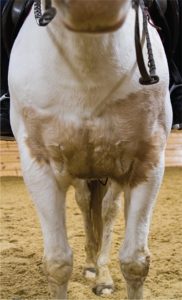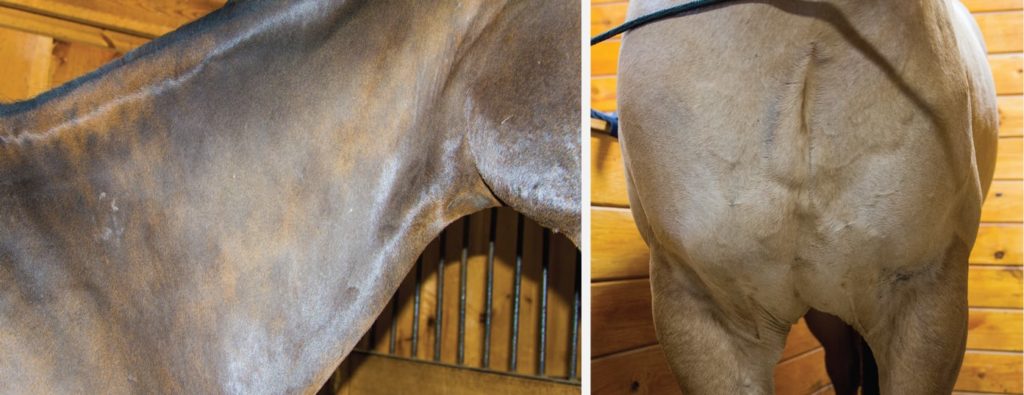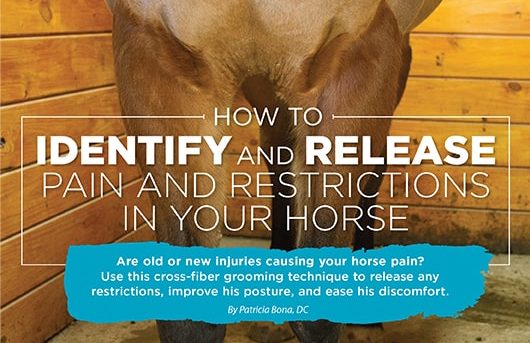Are old or new injuries causing your horse pain? Use this cross-fiber grooming technique to release any restrictions, improve his posture, and ease his discomfort.
We want our horses to be sound in mind and body, happy and healthy in play, and successful in their performance. But we often wrongly assume they are comfortable in their own skin when they may not be. Expanding your knowledge so you can recognize signs of pain and restriction, as well as any deficiencies in your horse’s posture, can help you improve his performance and overall well-being. Find it, feel it, fix it!
START WITH THE SKIN
The skin is the largest organ — it assists in regulating the horse’s temperature and eliminating sweat and toxins. It is also a sensory organ that provides information to the central nervous system. We want our horses to have shiny coats, but more importantly, we need to develop a better understanding of their skin and whether or not they’re comfortable in it.
Unfortunately, most horse caretakers and even equine professionals ignore scars, dents, and white hairs, believing they are just blemishes. But when the skin is not “fitting well”, and holds areas of tightness and restriction, scars and other flaws will appear. These blemishes can be a tell-tale sign that there’s an issue with the horse’s posture, movement, circulation, and lymphatic drainage. In other words, they’re red flags — sites of previous injuries and trauma that haven’t fully healed (see sidebar on next page). Even if the injury appears to be healed on the surface, there could be residual fascial restriction, possible pain, or a combination of the two.
ASSESS POSTURE

When is the last time you evaluated your horse’s posture? Did you compare both sides to see if they were symmetrical, and to see which side is “prettier”? Are the contours of the withers, the throat latch, and the shoulder the same from the left side to the right? Does your horse stand four-square with all cannon bones on the vertical? More than likely, one side will be prettier than the other. Often, this asymmetry correlates with training challenges, skin issues, or even lameness.
Good posture is defined by the symmetry and arrangement of the skeletal framework.
Good posture is defined by the symmetry and arrangement of the skeletal framework. In order for a horse to have good posture, we need to optimize the position and alignment of body parts so that we can achieve maximum symmetry. Good posture enables the horse to work efficiently in gravity, and reduces stress to the joints and strain to the soft tissues.
Irrespective of the horse’s conformation, when we optimize posture, we improve overall health and performance. Dr. Deb Bennett references conformation relative to the proportions of the horse’s skeleton. The skeletal anatomy of an adult horse is fixed. The length and size of the femur, forearm, or cannon bone will not change. Yet the arrangement and alignment of the skeleton can change — in other words, we can help a horse with poor posture.
OFFER CROSS-FIBER MASSAGE
The technique of cross-fiber massage, also known as traverse friction massage, originates in human scar, adhesion, and muscle therapy.
Generally, the muscle fibers of the horse run in the same direction as his hair. Run your hand along the underside of the neck to the shoulder, or from the croup down the point of the buttock to the hock — the muscles fibers run in that direction.
When you find dents and dings or scar tissue in those muscles, massage along the direction of the hair to release the adhesions between the skin and the muscles. Then palpate deeper to release fibrous restrictions, tension, and any gristly knots. The restrictions All photos courtesy of Makenzie Mann. may feel stringy or like plastic pebbles.
BLEMISHES = RED FLAGS
Before doing bodywork on your horse, scan his coat and body for these red flags. Take some photos of his posture (both right and left sides) and of any red flags you find, so you can compare the “before” and “after”.
- Dents
- Dings
- Bubbles
- Scars
- White hairs
- Hair disruptions
- Hollow spots
- Flat spots
- Irregularity in contours
Dents and dings are the most unrecognized red flags that negatively impact alignment and symmetry of the shoulders and pelvis. They are often located on the point of the shoulder, the front of the chest and neck, and on the buttock and around the hip.
These dents and dings are typically caused by a deep bloody bruise, also known as a hematoma. Hematomas can occur due to impact, such as from horses kicking each other and running into things. They often go unnoticed, especially in horses with thick coats, but the acute trauma to the tissue may or may not cause a lingering issue. Even after they’re healed, these bruises leave thickened, tighter muscle fibers and fascia, often resulting in a dent, ding, or bubble.
Observe your horse’s response as you relax and release these myofascial restrictions and trigger points. He may readjust the position of his feet, relax through his topline, or lick, chew and yawn.
Always work within your own safety limits and your horse’s tolerance as you do cross-fiber massage with your fingers or a curry or other tool of your liking. Hold onto the healing intention “find it, feel it, fix it” as you delve into the suspect areas.

The technique of cross-fiber massage, also known as traverse friction massage, originates in human scar, adhesion, and muscle therapy.
No blemish is too small to investigate. Akin to popping a stone out of a shoe or plucking that one piece of hair pulling on your pony tail, the relief can be astonishing.
Do not be surprised to find even more dents and dings, white hairs, and areas of no hair as your horse’s posture shifts and improves with more relaxed muscles and better joint alignment. As your horse becomes more comfortable in his own skin, the hair follicles and pores literally open at the lymphatic system and circulation improve. He may actually appear to have gained weight.
It is very rewarding to be able to observe changes in your horse’s comfort and posture as you work on him. If you find that some areas are very sensitive or reactive, apply a topical muscle salve like Sore No More or Limber Up to further ease discomfort as you do the crossfiber release. Post-exercise is a good time to work on particularly sensitive areas or specific sites as the muscles and fascia are warmed up and become softer.
The body is a self-lubricating system, and with a little time and attention, you can improve your horse’s posture, performance and overall well-being!

